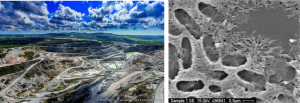Do microbes help make china clay? Kaolin minerals are very important economic resources; so much so that china clay has sometimes been referred to as “white gold”. Understanding how kaolin minerals form and behave in the environment is important because not only are they valuable economically, they also transport metals and nutrients to the ocean, can be used to remediate pollutants, and have been identified on the surface of Mars. Large kaolin deposits form from granites, either by hydrothermal alteration or by surface weathering in areas with temperate climates and high rainfall. Kaolin minerals also form in soils in intensely weathering environments. Kaolinization is thought to be triggered by the oxidation of iron(II) in biotite, and this has been linked to the activity of iron(II)-oxidising microorganisms. However, microbial iron(II) oxidation at neutral pH tends to occur in relatively narrow zones of redox interfaces rather than over tens of metres, which raises questions about its significance in economic kaolin deposits. This project will test the hypothesis that microbial redox cycling of iron contributes to kaolin formation in near surface environments, and therefore stimulating microbial redox cycling will increase the rate of kaolinization.
For full details see the attached file kaolinite PhD project description
